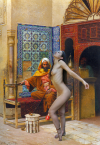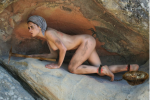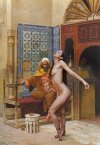I wonder if Kam-Aqhat is a character with whom the artist identifies? He has acquired an attractive addition to his household, and I imagine that Meri led a lengthy pursuit prior to her capture, since she has the slender, athletic physique of a sprinter. Her Egyptian loincloth is well observed, and together with the legible hieroglyphs on her collar pendant, this helps to define the period and location. These items are separate additions, carefully fitted to the figure, and the collar casts a subtle shadow on the skin.Kam-Aqhat's slavegirls : (1) Meri
Kam-Aqhat is a minor official at the court of Pharaoh Neb-khepesh-Re, also known as Apophis or Apepi, in Avaris.
He owns four slavegirls. His most recent acquisition is Meri, captured in the eastern desert by Kam-Aqhat himself.
Look higher up for Sclava - Meri's account of her capture.

The foreground and the feet have been cropped out, so we cannot identify precisely where Meri is standing. She appears quite tall compared to the architectural features, although the background does have a high eye level, or theoretical horizon. This is slightly above the balcony handrail, which coincides with Meri's eye level, and so it appears convincing, assuming a considerable distance between the figure and the building.
Whilst it might be tempting to increase the subtle blurring of the distant masonry and the palm tree in order to focus attention on Meri, it would be unfortunate to lose such interesting details from her new surroundings. The long depth of field helps to confirm a consistent direction of sunlight in the background and on the inserted figure, so I think it is justifiable. This is another example of neat blending to produce an illusion in which the figure appears to be an authentic part of the scene. Nice work, Kam!









